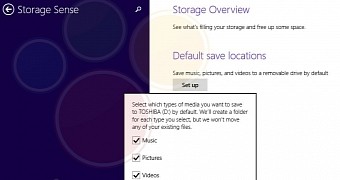Microsoft is already tweaking Windows 10 to better tackle the needs of PC users still relying on a mouse and keyboard, but the company used Windows Phone 8.1, a platform that’s powering its own handsets, as source of inspiration for some of the features designed for desktops.
For example, the notification center that was already available in the original Windows 10 Technical Preview build 9841 but was locked for all users, is based on the one seen in Windows Phone 8.1, with the feature lineup including most options that are now being offered to mobile phone users.
At the same time, two different options that were previously available on Windows Phone 8.1, namely Storage Sense and Wi-Fi Sense, were also spotted on testing builds of Windows 10, and now it appears that one more such feature is making its way to the desktop.
Brad Sams of Neowin, who already tried a newer version of Windows 10 Technical Preview, says that Battery Sense is also expected to be available to testers very soon.
Keep an eye on battery performance
The sole purpose of Battery Sense is to help users better manage available battery power and thus make sure that there’s enough juice to get your stuff done.
Battery Sense would thus provide an overview of the operating system, but also provide particular details about running apps, enabling you to close the ones draining your battery.
Needless to say, such an option would be exclusively available on tablets and laptops, where the battery clearly plays a key role for your running processes.
Battery Sense can be turned on automatically when power drops below 18 percent, thus disabling some of the processes in order to make the battery last longer.
Data Sense also in the works
Data Sense is also among the new features that could be released on Windows 10 devices, again based on similar tools available on Windows Phone 8.1.
As you could easily guess by simply reading its name, Data Sense would be specifically designed for helping you keep an eye on your data plan and make sure that you’re not paying too much money for browsing the web.
The feature will be very useful for those with tethered or metered connections, so there will also be options to limit transfers and get notifications when you’re about to exceed your plan.
At this point, all these features are still in development stage and a lot could change before Windows 10 comes out, but it’s pretty clear that Microsoft tries to make its new operating system capable of providing a similar experience across multiple devices.

 14 DAY TRIAL //
14 DAY TRIAL //